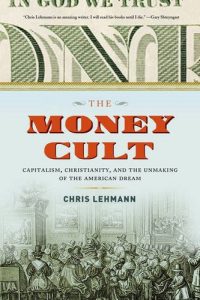At 400 pages, Chris Lehmann’s The Money Cult: Capitalism, Christianity, and the Unmaking of the American Dream examines in appropriate depth the “mystery [of] just how America’s once-austere and communal version of dissenting Protestantism developed into such a ripe recruiting ground for the sanctified capitalism of our financialized, upward-skewing, and uniquely destructive market order.”
Author Lehmann is neither a professional historian nor a religion specialist. He’s a brainy journalist, part of the Baffler set. His subtle treatment of complex subject matter reminds us that it’s always deep reading and a capacity to write clearly that matters most. His achievement reminds me of other significant historical works by “uncredentialed” scholars : T.J. Stiles on Cornelius Vanderbilt and George Armstrong Custer, James Bradley on racialized imperialism, and (most creditably) Douglas A. Blackmon on the significance of black convict labor.
The issues that Lehmann takes on here could not be more urgent for people constructed like me who fume and fuss over the near-total absence of a powerful religious critique of the sorry state of our affairs: today’s degraded and degrading “on demand” labor market, the triumph of what Lehmann calls “the functional cornering of markets trafficking in private access to formerly public goods,” the big money corruption in our politics, and (most of all) the meek resignation with which Americans simply accept this state of affairs.

The Money Cult: Capitalism, Christianity, and the Unmaking of the American Dream
Chris Lehmann
Melville House
May 18, 2016
In my view, the greatest single virtue of Lehmann’s approach is his firm rejection of reductionism, his refusal to assume that Protestantism’s accommodation of the capitalist agenda has been purely reactive and one-directional. He argues convincingly that standard secularization theory has never applied in America; religion here has hardly faded away in the face of secular imperatives, but an evolving religion has consistently cleared the way, spiritually, for capitalism’s next advance within a newly-cleared psychological and political space.
In a word, American Protestantism sanctified the market before the market even asked to be sanctified. It is profoundly depressing to acknowledge this, but Lehmann shows how capitalism has never had to point a gun at religion’s head to win the day: our “once austere” religion did this to itself. He vividly surfaces this sad reality at several critical junctures in the long narrative, pointing out, for example that Social Darwinism’s overall impact in the late 19th century pales in comparison to the runaway impact of Russell Conway’s “acres of diamonds” preaching. He demonstrates in a similar way how the postwar flowering of a potent culture of anti-union conservatism among Southern California’s evangelical and parachurch movements was entirely self-created and not simply the result of solicitation or manipulation by that era’s business leaders.
Say it again: religion did this to itself. It lost its critical edge, investing far too much in the potential of individual compassion rather than collective justice action. Lehmann notes that during the tumultuous 1880s and 1890s, the Social Gospel “had little more than a theatrical appeal for the restive heirs to the traditions of liberal Protestant reform.” During the Great Depression, liberal Protestants were effectively “paralyzed,” incapable of taking sides in the great class struggle of that era. And during the Great Meltdown of the 21st century’s first decade, one heard nary a hint of organized Protestant protest as Wall Street got bailed out while Main Street was left to fend for itself and as Bible Belt states decided that it was better for uninsured poor people to go without medical attention than to expand federally-paid Medicaid coverage or create health care exchanges under the Affordable Care Act.
At the root of this depressing defeat for a prophetic and socially-conscious Christian faith, in Lehmann’s reading, is what amounts to a strong and ever-present current of Gnosticism: the belief that I can rise above all obstacles and can transform myself and succeed against all odds with God’s help; that I can even transcend basic human limitations—suffering, illness, and death—and become God-like in my personal triumph. It’s always about me and “my” God; it’s never about transforming the social conditions that cause so much unnecessary suffering for so many.
Lehmann demonstrates how during times of the most acute public suffering, like the depressions of 1837, 1857, 1893, etc., almost all Protestant thought leaders served up new formulas for individual self-improvement rather than challenging the presumption and arrogance of wealth. Hence his title, “The Money Cult”: in what many are pleased to regard as a Christian nation, the functional faith of most believers has usually boiled down to a sanctified form of acquisitive individualism.
It’s not possible to summarize the full sweep of Lehmann’s narrative here, but his sensitive treatment of several important sub-themes deserves to be highlighted.
- Lehmann perceptively points out how every new pulse of revival, even Bruce Barton’s hugely successful portrayal of Jesus as a shrewd American businessman, has attempted to claim the mantle of Primitive Church authenticity;
- He shows how a strong hermetic folk religion was present from the beginning (even John Winthrop, Jr. was a devotee of magical thinking) and how a fascination with alchemy and buried treasure came into full flower in early Mormonism and later in Christian Science and other New Thought movements;
- He uncovers an ethic of sheer egoism in the thinking and writing of leading Transcendentalists Emerson and Channing;
- He explores the important later phase of William Jennings Bryan‘s long career, showing how even the Great Commoner lost his social critique in a haze of sentimentalism toward the end;
- He rightly calls attention to the very long and wide shadow cast by Norman Vincent Peale and the many instances of commonality between Peale and Billy Graham (including their shared mentorship of Robert Schuller);
- He shows how New Thought and prosperity preaching can easily, if not logically, coexist with premillennarian ideas about imminent destruction and judgment;
- He writes adeptly on the interplay between 1970s economic decline and its imposition of new gender roles, as well as the emergence of the Servant Leadership concept in conservative Protestant thought and in management theory;
- He carefully analyzes Joel Osteen‘s particular brand of prosperity faith as a kind of culmination of all the dubious currents that have been present all along.
In the course of telling the longer story of the money cult, Lehmann delights in surfacing little-known factoids. These include the remarkable number of commercial hucksters who were preachers or else preachers’ kids (e.g., Richard Bolles of What Color is Your Parachute? fame—a former Episcopal priest) and the equally remarkable number of notable preachers who had strong commercial instincts and/or commercial roots (ranging from 18th-century superstar evangelist George Whitefield to 19th-century revivalist giant Charles G. Finney and many others).
Lehmann corrects our usual impression that mainly lower-class types got swept into revivalism, pointing out that leading women and men also “got religion” during the great Cane Ridge Revival and similar upsurges. He reminds us that the main evangelical Christian critique of chattel slavery did not center on the exploitation of the enslaved but focused instead on the “depravity” of the slave owners’ ability to reap huge profits without having to work themselves. He presents readers with a tableau of characters whom we will forever see in a new light, such as the department store magnate John Wanamaker, a marketing genius who also believed passionately that born-again Christians would transform society, and the aforementioned Bruce Barton, who likewise carried forward a touch of Social Gospel idealism despite his reconfiguration of Jesus to suit the taste of the Roaring Twenties and his later involvement with the founding of advertising giant BBDO.
Lehmann also introduces readers to a few figures who are likely to be unfamiliar but who played significant roles somewhat below the radar, like Josiah Strong, an early Social Gospel leader who ended up championing the Spanish-American War and the need for “Anglo-Saxons” to Christianize the world. Also the deeply reactionary James W. Fifield, Jr., a pivotal architect of Southern California anti-union conservatism, and Kenneth Hagin, the godfather of the hugely influential Word of Faith movement.
A few minor quibbles: at one point Lehmann has late 18th-century “Calvinists” pitted against “Congregationalists,” which is confusing inasmuch as it was the “New Light” Calvinists who had drifted away from the idea of covenantal righteousness, whereas the Congregationalists sought to preserve the old austere communal religion. Similarly, Lehmann may be slightly ahead of himself in suggesting that acquisitive individualism was already an officially licensed behavior when Charles Grandison Finney was spearheading the Second Great Awakening. (It would be interesting to be a fly on the wall during a private conversation between Lehmann and Finney partisan Marilynne Robinson.) And, finally, a long chapter given over to a detailed exposition of the plot of the “Left Behind” books by Tim LaHaye and Jerry Jenkins delivered just too much of a muchness to suit this particular reader.
These quibbles aside, Lehmann has given us a sobering spiritual biography of a ceaselessly striving people—the powerful tribe of American Protestants—who, in Jesus’ memorable words, “honor me with their lips, but their hearts are far from me.”
Lehmann’s excavations may be sobering, but it is absolutely necessary for us to know this backstory if we are to have any hope of understanding the contemporary religious and political landscape, including the spiritual context that lies behind Trumpism’s rapid ascent.





